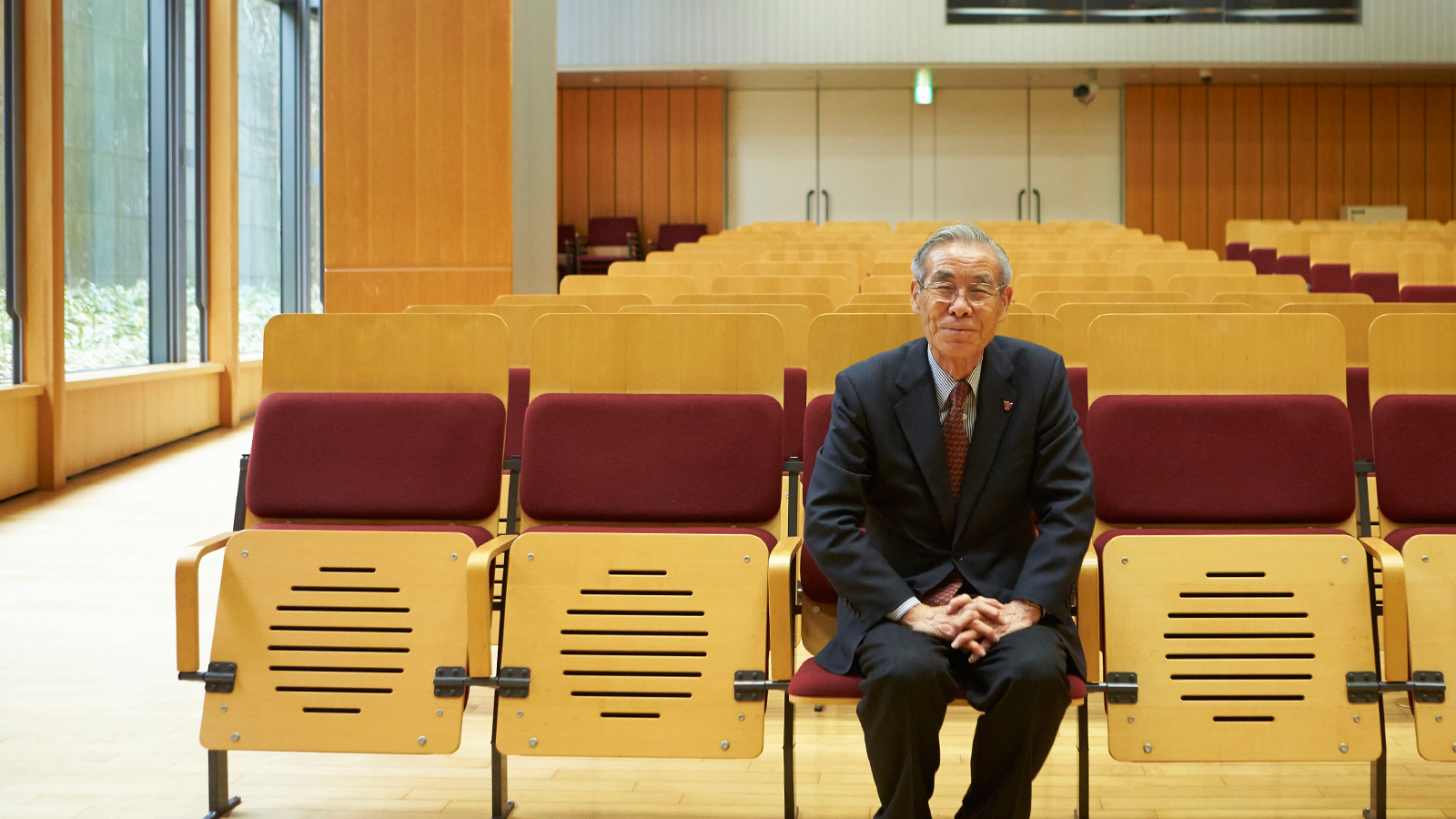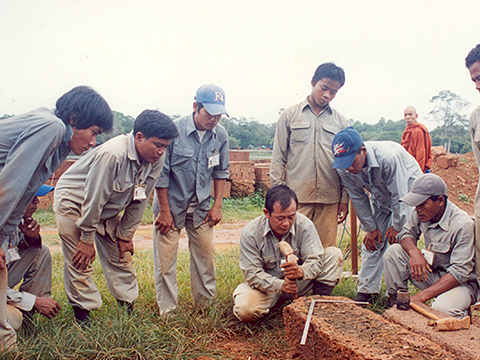
Column文化遺産コラム
It’s no exaggeration to say that the future of humanity rests on international cooperation activities in cultural heritage.
03.08.2016

Interviewee Yoshiaki Ishizawa
Director, Sophia Asia Center for Research and Human Development Professor (By Special Appointment), Sophia University
Chairperson, Japan Consortium for International Cooperation in Cultural Heritage
Areas of specialization: Southeast Asian history, cultural heritage, and monument inscriptions. While devoting many years to research and study of the ruins at Angkor in Cambodia and related human-resources development, Dr. Ishizawa is also involved in international cooperation activities with specialists and researchers in Japan and around the world and leading the JCIC-Heritage with its over 400 members.
Shocking news
Islamic State (IS) destroys the World Heritage Site Palmyra
In late August 2015, the Beelshamên Temple in the World Heritage Site Palmyra was destroyed. Then, in late October, the Arch of Triumph in the Palmyra ruins was destroyed as well. The ruins at Palmyra are the remains of a city that thrived from the first century, B.C., through the third century, A.D. Palmyra included shrines, an Arch of Triumph, an amphitheater, baths, and other structures from the Roman Empire. We would like to express our outrage at the barbaric act of destroying these monuments.
We are very uneasy about the possibility that cultural properties could be the subject of attempts to illicit trafficking through destructive activities targeting the ruins and museums of Syria and Iraq. In the event that such unlawfully obtained works of arts or antiquities were to be brought to Japan, the JCIC-Heritage intends to cooperate as much as possible in ensuring the repatriation.
JCIC-Heritage
Acts against destruction of cultural heritage and future actions following our 10th anniversary
In 2016, the JCIC-Heritage marked the 10th anniversary of its founding. The JCIC-Heritage was established originally by the Act on Promotion of International Cooperation on Preservation of Cultural Heritage (Diet members’ act no. 97 of 2006) as an organization to promote international cooperation. This law was passed thanks to the considerable efforts of many people, in particular the great artist Ikuo Hirayama and the Diet member Keiji Furuya. Under our JCIC-Heritage, more than 400 experts and researchers on the world’s cultural heritage help to preserve and restore cultural heritage overseas and take part in a wide range of other activities including advising on how to put cultural heritage to use in conjunction with economic cooperation. But why is there such a need to protect the world’s cultural heritage today? The answer is because we consider cultural heritage to be a cultural resource containing voluminous information. Drawing out this information can lead to new discoveries about the history, culture, and economy from ancient times, which can be exposed to the public through exhibitions of excavated artifacts.
This cultural heritage reflects our lives!
Angkor Wat is a complex of ruins that inspires the question of humanity
Cultural heritage itself is like a time tunnel connecting the past, present, and future, reproducing a venue for communication with the people of bygone times, through means including studying the ruins as a source of information, research, and tourism. The ancient capital of Angkor was built and developed based on a religious view of the universe. The ruins include monuments built in ways that evoke the hopes and prayers of the people of the past. They include the five giant pinnacles of Angkor Wat, the four Buddha faces of Bayon, the beautiful goddesses of Banteay Srei and the scenes from Hindu mythology carved in its walls—too many to count. The reliefs and paintings on the walls of these vast temples and halls inspire us to think deeply about how the people of that time lived and their hopes. Cultural heritage came to be considered to have universal value to all humanity about 30 years ago. This way of thinking was born, formed, grown, and deployed through the process of attempting to protect the heritage of humanity from economic overdevelopment, war, pollution, and other threats. It highly valued the natural environment and cultural heritage as embodiments of the natural uniqueness of an area and the diversity of its ethnic culture, with the goal of protecting both the natural environment and distinct ethnic cultures and traditions. It plays important roles around the world in preserving natural and human values that cannot be obtained with money and in expressing identity itself. The importance of cultural heritage and the significance of reconstructing scientific knowledge and studying cultural heritage are based on these roles.
In addition, projects to research, preserve, and restore cultural heritage stand in stark contrast to the phenomenon of globalization by showing us things such as unique local and ethnic traditions and the cultures of individual countries and regions.
A very important topic today
From preservation and restoration of cultural heritage to peace building: The case of Angkor Wat
Peace arrived at long last in Cambodia in 1993. For 24 years, the country had been embroiled in a civil war, divided into four factions. I visited Cambodia during the civil war. I saw the destruction and illegal excavation of cultural heritage with my own eyes. The same things are now taking place in Syria and Iraq today. I worked on the project to restore the Western Causeway of Angkor Wat (1996-2007), as a site for reconciliation, under the slogan of “Cambodians themselves working to preserve and restore Cambodia’s heritage.” This was truly a peace built through the restoration of ruins.
Preservation and restoration of the cultural heritage, and the results thereof, both energized the people of Cambodia and had the major national side effect of giving them pride in their culture and self-confidence. Surely for any ethnicity the opportunity to rediscover their own unique culture motivates people to think about their own country’s culture in greater depth, and scientific study of their cultural heritage gives them considerable pride and helps them to construct their own ethnic identity.
A message to children with inquisitive eyes
A proposal for school excursions
In my own experience, I encountered the vast ruins of Cambodia with almost no preconceptions. The simple surprise at wondering what they were inspired in me a very strong degree of curiosity.
As Benedict Anderson says (in Imagined Communities), in developing a national identity it is effective to make a “pilgrimage” around numerous sites in the nation. For example, why not have all elementary and middle-school students in Cambodia visit the ruins of Angkor on school excursions? In Japan, we have always visited Nara and Kyoto on school excursions, and this has helped us to recognize our own identity as Japanese people. It would be valuable to plan school excursions to cultural heritage sites, as well as fostering regional identity through means such as participation in mutual visits and training at cultural heritage sites. I believe that ideas such as working together to expand the school-excursion network are also very interesting.
Where shall we go next?
A proposal for an international rescue organization to protect cultural heritage from disasters
It is important to conduct specialized training in the field to be ready for disasters, by assigning disaster-prevention specialists to advise on protecting cultural heritage from disaster. In 2012, a flood struck the ruins of Ayutthaya. Through the lessons of this incident, I would like to propose that we construct the information exchange system and the network to prevent damage to cultural heritage caused by disasters.
Specifically, I propose that we begin by presenting information on cultural heritage in crisis. Then, the next tasks would be the collection of data and exchange of information on such cultural heritage. Particularly in Southeast Asia, large-scale natural disasters can occur at any time—these can include typhoons, cyclones, tsunamis and flooding, earthquakes, and fires. I would like to propose the development of a new structure for exchange of information and cooperation in disaster prevention in the field of protection and restoration for cultural heritage.







